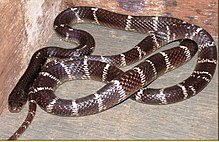Bungarus caeruleus
| Common krait | |
|---|---|
 |
|
| Scientific classification | |
| Kingdom: | Animalia |
| Phylum: | Chordata |
| Subphylum: | Vertebrata |
| Class: | Reptilia |
| Order: | Squamata |
| Suborder: | Serpentes |
| Family: | Elapidae |
| Genus: | Bungarus |
| Species: | B. caeruleus |
| Binomial name | |
|
Bungarus caeruleus (Schneider, 1801) |
|
| Synonyms | |
|
Pseudoboa caerulea Schneider, 1801 |
|
Pseudoboa caerulea Schneider, 1801
Bungarus candidus Var. CÆRULEUS Boulenger, 1896
The common krait (Bungarus caeruleus), also known as Indian krait or blue krait) is a species of venomous snake of the genus Bungarus found in the jungles of the Indian subcontinent. It is a member of the "big four" species, inflicting the most snakebites on humans in India.
The average length is 0.9 m (3.0 ft), but they can grow to 1.75 m (5 ft 9 in). Males are longer, with proportionately longer tails. The head is flat and the neck hardly evident. The body is cylindrical, tapering towards the tail. The tail is short and rounded. The eyes are rather small, with rounded pupils, indistinguishable in life. The head shields are normal, with no loreals; four shields occur along the margin of the lower lip; the third and fourth supraoculars touch the eye. The scales are highly polished, in 15-17 rows; the vertebral row is distinctly enlarged and hexagonal. Ventrals number 185-225 and caudals 37-50, entire.
Colouration is generally black or bluish black, with about 40 thin, white crossbars which may be indistinct or absent anteriorly. The pattern, however, is complete and well defined in the young, which are marked with conspicuous crossbars even anteriorly; in old individuals, the narrow white lines may be found as a series of connected spots, with a prominent spot on the vertebral region. A white preocular spot may be present; the upper lips and the belly are white.
"Shiyar chiti"(south 24 parganas) (South Bengal), শাহ-কানন (shah-kanon)(Bangladesh)
This species is found in Peninsular India from Sindh (Pakistan), to the West Bengal plains. It occurs throughout South India and Sri Lanka at elevations up to about 1600 m. It is also recorded from Afghanistan, Bangladesh, and Nepal.
...
Wikipedia
